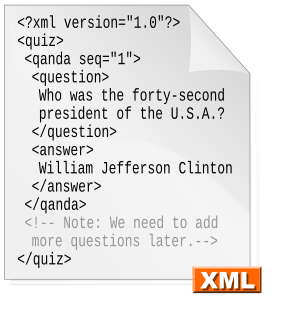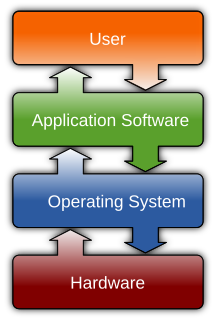DisplayML is an open, free-to-use protocol for encoding display information for display devices. It is based upon XML messages with a Request/Response model where the display device works as the server.

In computer text processing, a markup language is a system for annotating a document in a way that is syntactically distinguishable from the text. The idea and terminology evolved from the "marking up" of paper manuscripts, i.e., the revision instructions by editors, traditionally written with a blue pencil on authors' manuscripts. In digital media, this "blue pencil instruction text" was replaced by tags, which indicate what the parts of the document are, rather than details of how they might be shown on some display. This lets authors avoid formatting every instance of the same kind of thing redundantly. It also avoids the pointlessness of specifying fonts and dimensions, which do not even apply to many users.

A display device is an output device for presentation of information in visual or tactile form. When the input information that is supplied has an electrical signal, the display is called an electronic display.

Extensible Markup Language (XML) is a markup language that defines a set of rules for encoding documents in a format that is both human-readable and machine-readable. The W3C's XML 1.0 Specification and several other related specifications—all of them free open standards—define XML.
The interface between systems and display devices has historically required encoded character strings which, though successful, can lead to complexity in creation and debugging. DisplayML is easy to understand, since XML is a human readable format. The protocol is applicable to numerous display devices using various technologies such as LED, LCD, Bi-stable Magnetic, flip-disc display, VGA etc.

In computer programming, a string is traditionally a sequence of characters, either as a literal constant or as some kind of variable. The latter may allow its elements to be mutated and the length changed, or it may be fixed. A string is generally considered a data type and is often implemented as an array data structure of bytes that stores a sequence of elements, typically characters, using some character encoding. String may also denote more general arrays or other sequence data types and structures.

A light-emitting diode (LED) is a semiconductor light source that emits light when current flows through it. Electrons in the semiconductor recombine with electron holes, releasing energy in the form of photons. This effect is called electroluminescence. The color of the light is determined by the energy required for electrons to cross the band gap of the semiconductor. White light is obtained by using multiple semiconductors or a layer of light-emitting phosphor on the semiconductor device.

The flip-disc display is an electromechanical dot matrix display technology used for large outdoor signs, normally those that will be exposed to direct sunlight. Flip-disc technology has been used for destination signs in buses across North America, Europe and Australia, as well as for variable-message signs on highways. It has also been used extensively on public information displays. A few game shows have also used flip-disc displays, including Canadian shows like Just Like Mom, The Joke's on Us and Uh Oh!, but most notably the American game show Family Feud from 1976 to 1995.
DisplayML does not handle security. The protocol can be implemented at different levels depending on the type of display.
The DisplayML protocol supports file transfer, which makes it possible to send fonts, pictures or software to displays.

Computer software, or simply software, is a collection of data or computer instructions that tell the computer how to work. This is in contrast to physical hardware, from which the system is built and actually performs the work. In computer science and software engineering, computer software is all information processed by computer systems, programs and data. Computer software includes computer programs, libraries and related non-executable data, such as online documentation or digital media. Computer hardware and software require each other and neither can be realistically used on its own.
This page is based on this
Wikipedia article Text is available under the
CC BY-SA 4.0 license; additional terms may apply.
Images, videos and audio are available under their respective licenses.
HTML has been in use since 1991, but HTML 4.0 was the first standardized version where international characters were given reasonably complete treatment. When an HTML document includes special characters outside the range of seven-bit ASCII, two goals are worth considering: the information's integrity, and universal browser display.
SOAP is a messaging protocol specification for exchanging structured information in the implementation of web services in computer networks. Its purpose is to provide extensibility, neutrality and independence. It uses XML Information Set for its message format, and relies on application layer protocols, most often Hypertext Transfer Protocol (HTTP) or Simple Mail Transfer Protocol (SMTP), for message negotiation and transmission.
Web pages authored using hypertext markup language (HTML) may contain multilingual text represented with the Unicode universal character set. Key to the relationship between Unicode and HTML is the relationship between the "document character set" which defines the set of characters that may be present in a HTML document and assigns numbers to them and the "external character encoding" or "charset" used to encode a given document as a sequence of bytes.
Mathematical Markup Language (MathML) is a mathematical markup language, an application of XML for describing mathematical notations and capturing both its structure and content. It aims at integrating mathematical formulae into World Wide Web pages and other documents. It is part of HTML5 and an ISO standard ISO/IEC DIS 40314 since 2015.
Abstract Syntax Notation One (ASN.1) is a standard interface description language for defining data structures that can be serialized and deserialized in a cross-platform way. It is broadly used in telecommunications and computer networking, and especially in cryptography.
XML-RPC is a remote procedure call (RPC) protocol which uses XML to encode its calls and HTTP as a transport mechanism.
The term web service is either
The Sitemaps protocol allows a webmaster to inform search engines about URLs on a website that are available for crawling. A Sitemap is an XML file that lists the URLs for a site. It allows webmasters to include additional information about each URL: when it was last updated, how often it changes, and how important it is in relation to other URLs in the site. This allows search engines to crawl the site more efficiently and to find URLs that may be isolated from rest of the site's content. The sitemaps protocol is a URL inclusion protocol and complements robots.txt, a URL exclusion protocol.
In computer programming, whitespace is any character or series of characters that represent horizontal or vertical space in typography. When rendered, a whitespace character does not correspond to a visible mark, but typically does occupy an area on a page. For example, the common whitespace symbol U+0020 SPACE (HTML  ), also ASCII 32, represents a blank space punctuation character in text, used as a word divider in Western scripts.

The Network Configuration Protocol (NETCONF) is a network management protocol developed and standardized by the IETF. It was developed in the NETCONF working group and published in December 2006 as RFC 4741 and later revised in June 2011 and published as RFC 6241. The NETCONF protocol specification is an Internet Standards Track document.
The Transport Protocol Experts Group (TPEG) is a data protocol suite for traffic and travel related information. TPEG can be carried over different transmission media (bearers), such as digital broadcast or cellular networks. TPEG applications include, among others, information on road conditions, weather, fuel prices, parking or delays of public transport.
OMA Device Management is a device management protocol specified by the Open Mobile Alliance (OMA) Device Management (DM) Working Group and the Data Synchronization (DS) Working Group. The current approved specification of OMA DM is version 1.2.1, the latest modifications to this version released in June 2008. The candidate release 2.0 was scheduled to be finalized in September 2013.
RSS-TV is an XML-based navigation protocol for Internet media services based on the RSS standard.
Extensible Hypertext Markup Language (XHTML) is part of the family of XML markup languages. It mirrors or extends versions of the widely used Hypertext Markup Language (HTML), the language in which Web pages are formulated.
GEWI was founded in 1992 by Hagen Geppert and Dr. Karl Will. The “GEWI” name is derived from the first two letters of the two founders’ last names. GEWI began as a specialist developer of programmable hardware for global television manufacturers, with customers such as Sony and Grundig.
In 1997, GEWI produced one of the world’s first FM receivers to collect RDS-TMC data to display on video monitors at airports.







